Paris:Impressions of Life 1880-1925,opening at the Bendigo Art Gallery on March 16,is billed as a journey through the streets of historic Paris. The show uses almost 200 artefacts and works of art to tell the story of a city in flux as the forces of modernity reshape it into a metropolis that captured – and continues to capture – the global imagination.
Most of the show’s exhibits come from Paris’ Musée Carnavalet – an institution dedicated to telling the story of the French capital. When I ask lead heritage curator Anne-Laure Sol why she loves her city so much and why she would never live anywhere else,she protests that there are many reasons.
Pressed for an answer,she replies:“History is alive here;the past is alive. That is something very special about Paris. I adore the connection the city has between different periods. You can admire a building from the 19th century that’s sitting next to a building from the 17th century. You can stand in a small street that has kept the same shape since the time of Louis XIII,then walk into a wide avenue. I love this combination of times.”
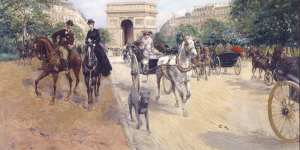
Georges Stein,“Cavaliers et attelages,avenue du Bois”.Musée Carnavalet–Histoire de Paris
And then there’s the light. The French have an evocative phrase for dusk – “entre chien et loup”,“between dog and wolf” – the fleeting moment when a darkening sky makes objects hard to distinguish. “I love this moment in Paris,the way that light falls on certain stone buildings,” says Sol wistfully. “It brings a certain … melancholy.”
Dusk is still hours away and heavy rain is bouncing off the cobblestones of the Marais district where Musée Carnavalet occupies two neighbouring mansions. Yet,it’s still possible to imagine the atmosphere Sol is describing because the curtains of the museum are drawn (it’s closed to the public on Mondays) and what light remains is illuminating the brass frame of Marcel Proust’s bed. It was here the neurotic,self-medicating author wrote his 3000-page masterpieceÀ la recherche du temps perdu (In Search of Lost Time). A nearby display cabinet contains his pocket watch. Lost time,indeed.
Bendigo Art Gallery’s curatorial manager,Lauren Ellis,explains the exhibition is conceived as a “series of promenades” taking visitors through a bustling street market,into a public garden and onwards to the banks of the Seine and the Eiffel Tower. They’ll experience the Bohemian nightlife of Montmartre and finish on the Champs-Élysées,the city’s best-known boulevard,where people from every social class rubbed shoulders and sought entertainment in theatres,circuses and skating rinks.
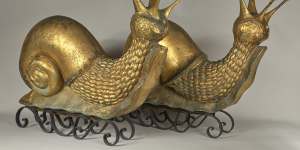
Unknown artisan,pair of signs from the snail merchant “Lazare Successors”.Musée Carnavalet – Histoire de Paris.
“You will feel like you’re moving through the city,” says Ellis. “One of the things that gives Paris its charm and contributes to the magic of the city is that it is very human scale. It’s a densely populated city,but because of its very elegant,symmetrical buildings it doesn’t feel like that.”
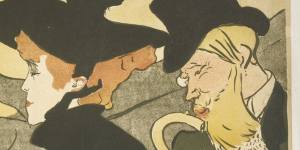
Henri de Toulouse-Lautrec,poster for the cabaret venue Divan Japonais at 75 rue des Martyrs,1892.Musée Carnavalet–Histoire de Paris
The artefacts drawn from Musée Carnavalet’s collection are eclectic. They include a pair of large gold-painted snails that advertised a gastropod merchant’s premises at a time when literacy and street numbers were in short supply.
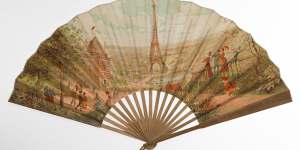
Souvenir fan with panorama of the 1889 Universal Exhibition.Musée Carnavalet–Histoire de Paris
There’s a poster designed by Henri de Toulouse-Lautrec advertising the cabaret venue Divan Japonais and a fan depicting the newly erected Eiffel Tower sold at one of the Universal Exhibitions designed to telegraph Paris’ achievements to the world.
A painting by Ludovic Vallée shows a group of well-heeled citizens in Parc Montsouris,one of the green spaces created in the mid-19th century by Napoleon III. One of the more unusual objects is a little replica of a can-can dancer’s leg that once sat on the counter of a bar. Customers would spin the leg and if it came to rest pointing in their direction they’d have to shout their friends a drink. It’s a reminder that while sober technological advances were changing the city’s skyline,society was also cutting loose and enjoying itself.
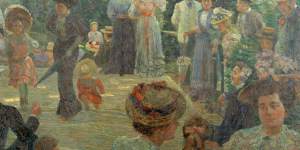
Ludovic Vallée,Parc Montsouris,view toward the bandstand,c1900.Musée Carnavalet–Histoire de Paris
For many Parisians – at least those with disposable income – this was a “wonderful time”,says Sol. “In Montmartre there were dozens of cabarets that opened from 1890 onwards. When one closed,five new ones opened. A popular singer like Yvette Guilbert would perform in five or six cabarets a night because everyone wanted to see her.”
The only items in the exhibition not from Musée Carnavalet are costumes from the period loaned by the National Gallery of Australia and the NGV. Says Ellis,“when we first approached Anne-Laure with the idea of borrowing them I’m sure she was a bit wary. But she was astonished at what these exceptional pieces of historic French couture add to the show.”
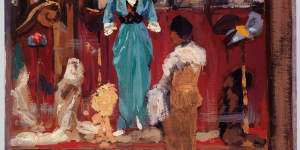
Eugène Louis Gillot,Front of a fashion store,1910.Musée Carnavalet – Histoire de Paris
While Paris is often described as “timeless”,much of the city we know and love was created in the period covered by the exhibition. Two of its landmarks – the Eiffel Tower and Sacre-Coeur – were completed in 1889 and 1914 respectively. This was also the era that saw the proliferation of the city’s famous boulevards,its public parks and the bridges across the Seine. Says Sol:“The city underwent a massive transformation and people who were used to living in a Middle Age city must have found it incredible. Today,in the centre of Paris,we are living in a 19th century city.”
Ellis concurs. “We have this idea of Paris as an almost timeless,picture-postcard city – you’d think it had been standing for 500 years. But actually,relative to some other picturesque European capitals,it’s pretty recent.”
The year 1880 is often associated with the start of the Belle Époque,a golden age characterised by peace (a relatively rare commodity in Europe for much of the 19th century),optimism and technological,scientific and cultural innovation. It was a time when the arts flourished and wealth began to filter down to what would now be called the middle classes.
One of the posters inParis:Impressions of Life 1880-1925 advertises a new department store by depicting an elegantly dressed woman inspecting household linen. She was part of a burgeoning class that also demanded more sophisticated entertainment,clothes that weren’t simply utilitarian and food that satisfied more than hunger.
While the transformation of Paris at this time was very real,it went hand in hand with the city’s efforts to shape its own image. Says Ellis,“the phrase ‘Belle Époque’ is interesting because in some ways it does go to one of the central tensions of telling a story about Paris at this time – a time when we find the origins of a heavily mythologised and romanticised idea of the city. That[idea] can be traced back to this period when the city was re-landscaped and embarked on an intentional image-making project,constructing a mythology then packaging it and exporting it.”
So,why doesn’t the phrase “Belle Époque” appear in the title of the Bendigo exhibition? Partly,because it wouldn’t be accurate – it was curtailed by the start of World War I in 1914,while the exhibition covers the period up to 1925 – but also because the notion is contested. Says Sol,“The Belle Époque is an invention that came a long time after this period – it’s a creation. Yes,it was a time of prosperity and a lot of creativity,but these were also very difficult times for a lot of people.”
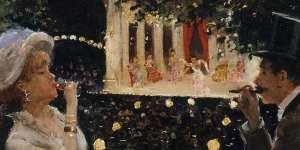
Jean Beraud,Dinner at the Ambassadeurs,c.1880 (detail). Musée Carnavalet–Histoire de Paris
Those difficult times don’t tend to feature in the Paris of the popular imagination;the place known worldwide as the city of light,the city of romance. And that,says Ellis,is no accident. “You quickly get the sense that the city fully understood it had this magical,poetic quality. There are paintings in the exhibition from the 19th century showing couples in cafes lit with strings of lights that play directly to the idea of romance – things you’d still see in a rom-com made today.
“Obviously,the city isn’t run by a cabal,but there’s a general understanding that it has acquired a romantic quality through design and a series of happy accidents. It has managed to articulate these ideas into highly recognisable symbols such as the Arc de Triomphe and the Eiffel Tower,that freight them powerfully around the world.”
Paris in popular culture
Paris,in the immortal words of Cole Porter,is a “timeless town”;easy to love in summer,winter,spring and autumn too. To be fair,the American composer,who moved there in 1917 and fell into the embrace of its demi-monde,had good reasons to adore his adopted home. But even so,I Love Paris seems to be written by a man wearing a particularly opaque pair of “lunettes roses”. “I love Paris in the summer when it sizzles,” he declares. “I love Paris in the winter when it drizzles.”
To be fair,Porter is far from alone when it comes to depictions of the city of light as a charming urban idyll. Fast-forward two decades to post-punk England – not an era renowned for its sentimentality – and you find Marianne Faithfull using an idealised image of the French city inThe Ballad of Lucy Jordan. The song’s bored suburban housewife realises with a jolt she’ll never “ride through Paris in a sports car/With the warm wind in her hair.”
Even Joni Mitchell,a lyricist not given to easy sentiment,adopts a somewhat touristic view in 1974’sFree Man in Paris. The song describes a city where a foreigner – the music impresario David Geffen by all accounts – can feel “unfettered and alive” as he goes “Down the Champs-Élysées/Going cafe to cabaret”.
Presumably,it’s easier to write gritty songs about Paris if you’re from there. Cue French new wavers Taxi Girl who,in their notorious mid-1980s dittyParis,ask,“Hey mate,how do you spell Paris?” Answer:“Paris is spelled S-H-I-T”.
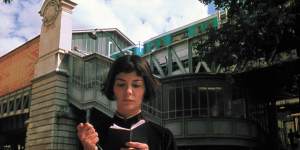
Audrey Tautou in Amelie.Supplied
Film and television depictions of Paris,particularly those aimed at international audiences,tend to owe more toAmelie and Woody Allen’sMidnight in Paris thanLa Haine,the gritty 1995 thriller about immigrants living in a suburb far removed from the fancy arrondissements. Another,very different take on the city,comes courtesy of Jean-Luc Godard’sAlphaville,a 1965 movie that uses its modernist architecture as the alienating backdrop to a spooky sci-fi noir.
ButLa Haine andAlphaville aren’t the norm. Films ranging from 1958’sGigi – elegant clubs and moonlit walks by the Seine – to 2006’s Paris,je t’aime,are part of a procession of big- and small-screen representations of the city as a poetic place where romance is as inevitable as a glimpse of the Eiffel Tower. In this version of Paris the streets are always cobbled,the cafes are always chic and the locals are endlessly entertained by tourists’ hamfisted attempts at speaking their language.

Lily Collins feeds the tourist fantasy in Emily in Paris.Netflix
The runaway success of Netflix’sEmily in Paris – watched by 58 million households in the month after its debut in 2020 – suggests the idea of a fairytale Paris is as potent as ever. Created by DarrenSex in the City Star,it’s the tale of a young American woman who moves to Paris for work only to find her peppy pragmatism at odds with every Gallic cliche imaginable. In this version of Paris everyone is arrogant,work-shy and flirtatious;lunch breaks go on forever and nobody’s plumbing works. All the men are gorgeous – the chef,the semiotics professor et al – and the women,hostile at first,inevitably succumb to our heroine’s cheerful decency.
The fourth season of what is,surely,the most potent example of Parisian myth-making in recent times,will be aired later this year. In the meantime,there’s an official Emily walking tour and something called the “Emily Effect”:a survey suggested that among those who watched the series,54 per cent said they would live or work in France,compared with 25 per cent of those who had not. As Emily herself would say,“A little ‘bonjour’ goes a long way!”
Paris:Impressions of Life 1880-1925 is at Bendigo Art Gallery,March 16 – July 14. Richard Jinman travelled with the assistance of the gallery.
